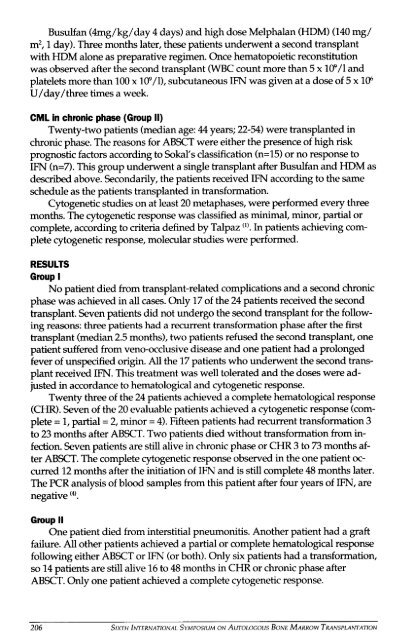VI Autologous Bone Marrow Transplantation.pdf - Blog Science ...
VI Autologous Bone Marrow Transplantation.pdf - Blog Science ...
VI Autologous Bone Marrow Transplantation.pdf - Blog Science ...
Create successful ePaper yourself
Turn your PDF publications into a flip-book with our unique Google optimized e-Paper software.
Busulfan (4mg/kg/day 4 days) and high dose Melphalan (HDM) (140 mg/<br />
m 2<br />
,1 day). Three months later, these patients underwent a second transplant<br />
with HDM alone as preparative regimen. Once hematopoietic reconstitution<br />
was observed after the second transplant (WBC count more than 5 x 10V1 and<br />
platelets more than 100 x 10 9<br />
/1), subcutaneous IFN was given at a dose of 5 x 10 6<br />
U/day/three times a week.<br />
CML in chronic phase (Group II)<br />
Twenty-two patients (median age: 44 years; 22-54) were transplanted in<br />
chronic phase. The reasons for ABSCT were either the presence of high risk<br />
prognostic factors according to Sokal's classification (n=15) or no response to<br />
IFN (n=7). This group underwent a single transplant after Busulfan and HDM as<br />
described above. Secondarily, the patients received IFN according to the same<br />
schedule as the patients transplanted in transformation.<br />
Cytogenetic studies on at least 20 metaphases, were performed every three<br />
months. The cytogenetic response was classified as minimal, minor, partial or<br />
complete, according to criteria defined by TalpazIn patients achieving complete<br />
cytogenetic response, molecular studies were performed.<br />
RESULTS<br />
Group I<br />
No patient died from transplant-related complications and a second chronic<br />
phase was achieved in all cases. Only 17 of the 24 patients received the second<br />
transplant. Seven patients did not undergo the second transplant for the following<br />
reasons: three patients had a recurrent transformation phase after the first<br />
transplant (median 2.5 months), two patients refused the second transplant, one<br />
patient suffered from veno-occlusive disease and one patient had a prolonged<br />
fever of unspecified origin. All the 17 patients who underwent the second transplant<br />
received IFN. This treatment was well tolerated and the doses were adjusted<br />
in accordance to hematological and cytogenetic response.<br />
Twenty three of the 24 patients achieved a complete hematological response<br />
(CHR). Seven of the 20 évaluable patients achieved a cytogenetic response (complete<br />
- 1, partial = 2, minor = 4). Fifteen patients had recurrent transformation 3<br />
to 23 months after ABSCT. Two patients died without transformation from infection.<br />
Seven patients are still alive in chronic phase or CHR 3 to 73 months after<br />
ABSCT. The complete cytogenetic response observed in the one patient occurred<br />
12 months after the initiation of IFN and is still complete 48 months later.<br />
The PCR analysis of blood samples from this patient after four years of IFN, are<br />
negative

















